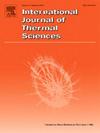取向对蒸发的影响限制了乙醇在多孔薄条上的扩散
IF 4.9
2区 工程技术
Q1 ENGINEERING, MECHANICAL
International Journal of Thermal Sciences
Pub Date : 2025-07-21
DOI:10.1016/j.ijthermalsci.2025.110159
引用次数: 0
摘要
排汗是一种广泛研究的现象,其应用范围涵盖自然过程和工业系统,例如热管中用于温度控制的液体蒸发。这项研究调查了一种简化的情况,即乙醇在薄滤纸上水平扩散,然后蒸发。实验使用三种不同渗透率的滤纸进行,并使用光学和热成像技术捕获数据。水平取向滤纸的稳态扩散长度(Lc)显著小于Jurin定律的预测值,说明蒸发是扩散过程的主要限制因素。有趣的是,水平配置的Lc值比垂直配置的Lc值大30%,强调了重力在垂直情况下的显著影响。热成像进一步揭示了一个不均匀的温度分布,在液体扩散的中点附近观察到一个反转。利用这种非线性温度分布,我们将先前提出的非恒定蒸发模型(NCEM) (Murthy and Kumar 2025[1])应用于水平配置,忽略重力效应(g=0),该模型最初用于垂直情况。NCEM假设蒸发速率与局部邪恶长度呈幂律依赖关系,是对恒定蒸发模型(CEM)的改进(Fries等人,2008[2]),后者假设整个邪恶长度均匀蒸发。修正后的NCEM (Murthy和Kumar 2025[1])得到的h - t曲线与实验数据非常接近。此外,我们利用以前开发的无因次数,有效地将各种h - t曲线整合到一个统一的主曲线中。这些发现提供了对排芯和蒸发动力学的更深入的了解,对诸如排芯和热管等热管理技术具有重要意义。本文章由计算机程序翻译,如有差异,请以英文原文为准。
Impact of orientation on evaporation limited spreading of ethanol on thin porous strips
Wicking is a widely studied phenomenon with applications spanning natural processes and industrial systems, such as the evaporation of liquids in heat pipes for temperature control. This research investigates a simplified scenario where ethanol spreads horizontally over thin filter papers, followed by evaporation. Experiments were conducted using three types of filter paper with varying permeability, and data were captured using optical and thermal imaging techniques. The findings for horizontally oriented filter papers revealed that the steady-state spreading length was significantly shorter than predicted by Jurin's law, highlighting evaporation as the primary limiting factor in the spreading process. Interestingly, values for horizontal configurations were ∼30 % greater than their vertical counterparts, underscoring the significant influence of gravitational forces in vertical cases. Thermal imaging further revealed a non-uniform temperature distribution, with an inversion observed near the midpoint of the liquid's spread. Using this nonlinear temperature profile, we applied the previously developed Non-Constant Evaporation Model (NCEM) (Murthy and Kumar 2025 [1]), originally proposed for vertical cases, to the horizontal configuration by neglecting gravitational effects . The NCEM, which assumes a power-law dependence of the evaporation rate on the local wicked length, served as an improvement over the Constant Evaporation Model (CEM) (Fries et al., 2008 [2]), which presumes uniform evaporation across the wicked length. The modified NCEM (Murthy and Kumar 2025 [1]) yielded curves that closely aligned with the experimental data. Additionally, we utilized the previously developed dimensionless numbers, which effectively consolidated various curves into a unified master curve. These findings provide deeper insights into the dynamics of wicking and evaporation, with significant implications for thermal management technologies such as wicks and heat pipes.
求助全文
通过发布文献求助,成功后即可免费获取论文全文。
去求助
来源期刊

International Journal of Thermal Sciences
工程技术-工程:机械
CiteScore
8.10
自引率
11.10%
发文量
531
审稿时长
55 days
期刊介绍:
The International Journal of Thermal Sciences is a journal devoted to the publication of fundamental studies on the physics of transfer processes in general, with an emphasis on thermal aspects and also applied research on various processes, energy systems and the environment. Articles are published in English and French, and are subject to peer review.
The fundamental subjects considered within the scope of the journal are:
* Heat and relevant mass transfer at all scales (nano, micro and macro) and in all types of material (heterogeneous, composites, biological,...) and fluid flow
* Forced, natural or mixed convection in reactive or non-reactive media
* Single or multi–phase fluid flow with or without phase change
* Near–and far–field radiative heat transfer
* Combined modes of heat transfer in complex systems (for example, plasmas, biological, geological,...)
* Multiscale modelling
The applied research topics include:
* Heat exchangers, heat pipes, cooling processes
* Transport phenomena taking place in industrial processes (chemical, food and agricultural, metallurgical, space and aeronautical, automobile industries)
* Nano–and micro–technology for energy, space, biosystems and devices
* Heat transport analysis in advanced systems
* Impact of energy–related processes on environment, and emerging energy systems
The study of thermophysical properties of materials and fluids, thermal measurement techniques, inverse methods, and the developments of experimental methods are within the scope of the International Journal of Thermal Sciences which also covers the modelling, and numerical methods applied to thermal transfer.
 求助内容:
求助内容: 应助结果提醒方式:
应助结果提醒方式:


